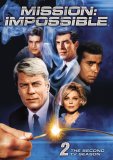Mission Impossible didn’t really enter into its by now famous format until this, the second season. The IMF team was run by Daniel Briggs, played by Steven Hill. Hill was never really happy and left after the first season, citing a refusal to work on the Sabbath as his reason for leaving. While Hill was never bad in the role, his departure was our gain. Peter Graves immediately stepped up as the iconic Mr. Phelps, and Mission Impossible as we know it was born. I should add a word of caution and say this is really …othing like the films which have become big budget vehicles for Tom Cruise over the last decade or so. This was not an explosive f/x or stunt driven show. The team managed their impossible missions with cunning and guile. The team was necessarily eclectic in nature. It featured Martin Landau in his signature role of Rollin Hand. Hand was very much akin to Martin Ross and his role in The Wild Wild West. He was a master of disguise. He could imitate almost anyone in very short order. Barney Collier was the gadget man, played by Greg Morris. Cinnamon Carter was the model and the team’s chief seductress and was played by Landau’s real life wife Barbara Bain. Finally, the muscle was supplied by Willy Armitage, played by brute Peter Lupus. Together they took on missions that the government could not be officially a part of. They were always admonished that should they be caught “the secretary would disavow any knowledge” of them. Usually they were sent somewhere to put some evil mastermind out of business. Their tactics ranged from scams to outright theft. Sometimes they were a rescue team while other times they would infiltrate a group of bad guys. There were certainly cold war elements to the whole thing.The openning segment of each episode was television history. A hidden tape recorder would give Phelps his assignment with the warning that the recording would self-destruct in 5 seconds. The tape and usually the recorder as well went up in a puff of smoke leading to the famous fuse and theme. Before we knew it we were off to save the world one week at a time.
Video
Each Mission Impossible episode is presented in its original television full frame format. We’re talking about a 40 year old television show, and your expectations should be adjusted accordingly. Overall the transfers are remarkably solid. While colors are a bit soft, the picture itself is rather clean. Print defects are minimal when you consider the age. Black levels are noticeably stronger than in other shows I’ve seen from this era.
Audio
Mission Impossible was supplied with a nice bit of regard for the fans. A Dolby Digital 5.1 track was created for the show. Certainly you won’t find that it stands up to today’s modern ear poppin’ audio sensation but it is a fine effort all the same. Dialogue is clear and front and center, exactly where it should be. The addition of the surrounds is usually subtle but allow for a new experience for this rather old series.
Special Features
Unfortunately that fan respect was missing in the extras department..
Final Thoughts
Mission Impossible was for a couple of years a sister show to Star Trek. Both were produced by DesiLu and involved Herb Solo. Leonard Nimoy would later join the IMF team. If you are expecting anything like the Cruise films, I’m afraid you’re in for a letdown. But here’s the deal. This show excelled at presenting clever schemes to bring about their results. The series seldom cheated. You need to be able to look for that sinister resourcefulness that made each mission exciting. That, dear reader, is “your mission should you decide to accept it”.





